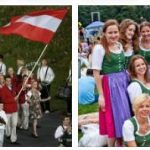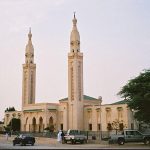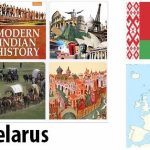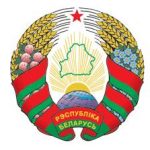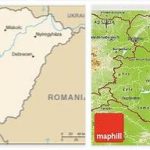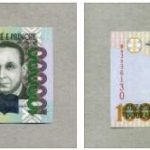Belarus (colloquially Belarus) is a landlocked country in Eastern Europe with (2019) 9.5 million residents; The capital is Minsk. Belarus borders Russia to the north and east, Ukraine to the south, Poland to the west and Lithuania and Latvia to the northwest.
Belarus is located in the west of the Eastern European (Russian) Plain in the catchment area of Memel, Daugava, the middle Dnieper and Pripet. The surface forms were largely shaped by the Pleistocene inland glaciation. Glacial landfill landscapes with a clear zoning from north to south are widespread. The Polotsk lowland in the far north on both sides of the upper Daugava is a glacial reservoir filled with sand and banded clay, muddy and rich in lakes.
To the south follow further plains interrupted by moraine ranges, which are bounded by the high zone of the Belarusian ridge, a 500 km long terminal moraine landscape (highest point: Dzjarshynskaya, 345 m above sea level), which is divided into individual, by the flat valleys of Beresina and Dnieper divided into separate heights. Further to the south, up to the edge of Polesia, there are glacial plateaus consisting of sand and clays. The flat marshland region of Polesia extends in the catchment area of Pripjet, Dnieper and Desna.
Population
84% of the population are Belarusians. The minorities include Russians (8%), Poles (3%), Ukrainians, Tatars and others. Only 60% of Belarusians consider Belarusian to be their mother tongue. Russian is predominantly spoken as the lingua franca in everyday life and in commerce, in schools and authorities.
Due to the low birth rate, the population is declining slightly. With (2018) 47 residents / km 2 Belarus is one of the sparsely populated countries in Europe. The lowest population density is in Polesia in the south. The share of the urban population is 79% (2018). According to trackaah, over a fifth of the population lives in the capital Minsk.
The biggest cities in Belarus
| Largest cities (inh. 2019) *) | |
| Minsk | 1 992 700 |
| Gomel (Homel) | 536 900 |
| Mogiljow (Mahiljou) | 383 300 |
| Vitebsk (Vitebsk) | 378 400 |
| Grodno (Hrodna) | 373 500 |
| *) Belarusian form in brackets | |
Social: Although official unemployment is below 1%, underemployment and low wages result in a low standard of living for large sections of the population. Many people try to supplement their income through illegal work and corruption.
Religion
The constitution guarantees freedom of religion and protects the practice of religion if it is done with respect for the spiritual, cultural and national traditions of the Belarusian people. The State Commission for Religious and National Affairs is responsible for regulating relations between the state and religious communities. Registration there is a prerequisite for religious communities to exercise their rights related to religious freedom. The basis of the state’s religious policy is the law on religion passed in 2002, the basic provisions of which are based on the law of religion in Russia and the Orthodox Church as a representative of Belarusian national identity, she grants a prominent position compared to the other religious communities (confirmed in 2003 by a cooperation agreement concluded between the government and the Orthodox Church).
The Orthodox Church in Belarus, elevated to an exarchate by the Moscow Patriarchate in 1989, acquired the status of an autonomous church in matters of internal administration after the declaration of state independence from Belarus as a Belarusian Orthodox Church. Different institutions provide partly very different results on religious affiliation: According to this, between around 48 and 73% of the population profess Orthodox Christianity. Small numbers of Orthodox minority groups form the Old Believers (Raskolniki) and members of the Belarusian autocephalous Orthodox Church (1942/49 autocephaly declaration; church jurisdictions in the Belarusian diaspora in Canada and the USA), which is neither state nor ecclesiastical (on the part of general orthodoxy). According to various sources, between around 7 and around 12% of the population belong to the Catholic Church (including a very small Greek Catholic minority). It includes the Archdiocese of Minsk-Mogilev (seat: Minsk) with the suffragan dioceses Grodno, Pinsk and Vitebsk. In addition, there are a number of Protestant denominations (especially Pentecostals and Baptists; around 15 denominations in total), which together have an estimated proportion of the population of less than 2%.
Non-Christian religious minorities are the Jews and Muslims. The Jewish community with its center and seat in Minsk has an estimated 0.3–0.4% of the population; which is about 30,000 to 40,000 believers (in comparison, in 1926 there were about 407,000 Jews in the Belarusian SSR, 1989 still about 110 000, the Holocaust destroyed almost completely Jewish culture, their history in what is now Belarus into the 14th century.)
The Muslim minority (around 0.2–0.5% of the population) includes Tatars (who have lived in what is now Belarus since the time of the Golden Horde) and immigrants from the former Central Asian Soviet republics. Around 41% of the population do not belong to any religious community.
Soligorsk
Soligorsk, Belarusian Salihorsk, city in Minsk region, Belarus, in Polesia, (2019) 106,500 residents; chemical industry based on the Starobin potash deposits south of Soligorsk, textile industry. Soligorsk was founded in 1958 without a previous settlement and has been a town since 1963.

